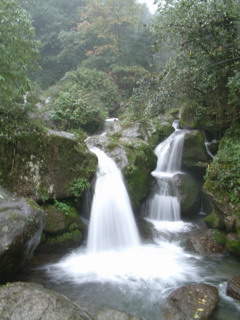geo.wikisort.org - Mountains
Mount Qingcheng (Chinese: 青城山; pinyin: Qīngchéng Shān) is a mountain in Dujiangyan, Chengdu, Sichuan, China.
| UNESCO World Heritage Site | |
|---|---|
 | |
| Location | Dujiangyan City, Chengdu, Sichuan, People's Republic of China |
| Part of | Mount Qingcheng and the Dujiangyan Irrigation System |
| Criteria | Cultural: (ii)(iv)(vi) |
| Reference | 1001 |
| Inscription | 2000 (24th Session) |
| Coordinates | 31°0′6″N 103°36′19″E |
 | |
UNESCO World Heritage Site | |
| Part of | Mount Qingcheng and the Dujiangyan Irrigation System |
| Criteria | Cultural: |
| Reference | 1001 |
| Inscription | 2000 (24th Session) |
It is considered one of the birthplaces of Taoism (Daoism)[1] and one of the most important Taoist centres in China. In Taoist mythology, it was the site of the Yellow Emperor's studies with Ning Fengzi. As a centre of the Taoist religion it became host to many temples. The mountain has 36 peaks. It is home to Dujiangyan Giant Panda Center and since 2000 has been listed as a UNESCO World Heritage Site.[2] Mount Qingcheng was affected by the Wenchuan Earthquake in 2008.[3][4]
History
In 142 AD, the philosopher Zhang Daoling developed the Way of the Five Pecks of Rice, a prominent movement in Taoism.[2] Many of the essential elements of Taoism derived from the teachings and practices of the temples that were built on the mountain during the Jin and Tang Dynasties. There are 11 Taoist temples on the mountain, and Mount Qingcheng was an important spiritual and philosophical center until the 17th century.[2]
Places of Interest
- Jianfu Palace
"Located at the foot of Mount Zhangren, Jianfu Palace was firstly built in the Tang Dynasty and repeatedly renovated in the following dynasties. There are only two halls and three compounds renovated in the Qing Dynasty left today. Leading figures of the Taoist school are worshiped in the splendid Main Hall of Jianfu Palace. In Weixin Pavilion, the dresser of the Princess consort of Prince Qingfu in the Ming Dynasty.
It is the first Taoist temple on Mount Qingcheng."[1]
- Chaoyang Cave
"Located at the foot of the main peak of Mount Laoxiao, the Cave is deep, with drops of water falling down occasionally. Chaoyao Cave is also a magnificent Taoist temple built under steep cliffs which are part of the terrain."[1]
- Shangqing Palace
"Located at the peak of Mount Qingcheng with an altitude over 1500 m, Shangqing Palace marks the end of the touring route of Mount Qingcheng. Buildings such as Laojun Hall, Sanqing Hall, Wenwu Hall, and Tao Te Ching Preaching Hall in the Taoist temple of Shangqing Palace with several cultural relics, were originally built in the Jin Dynasty."[1]
Gallery
- Front Gate of Mount Qingcheng
- Front Gate of Mount Qingcheng
- Waterfalls at Mount Qingcheng
- Tai'an Ancient Village at the foot of Mount Qingcheng
See also
- Qingchengshan railway station, named after the Mount Qingcheng in Dujiangyan, Chengdu, Sichuan Province, China
References
- "Mount Qingcheng - One of the birthplaces of Chinese Taoism".
- "Mount Qingcheng and the Dujiangyan Irrigation System". UNESCO World Heritage Centre. United Nations Educational, Scientific, and Cultural Organization. Retrieved 10 Apr 2021.
- Nan, Shun-xun; Foit-Albert, Beverly (2007). China's Sacred Sites. Himalayan Institute Press. p. 160. ISBN 9780893892623.
- Hargett, James M. (16 February 2012). Stairway to Heaven: A Journey to the Summit of Mount Emei. SUNY Press. p. 54. ISBN 9780791482186.
External links
 Media related to Mount Qingcheng at Wikimedia Commons
Media related to Mount Qingcheng at Wikimedia Commons- Mount Qingcheng and the Dujiangyan Irrigation System: the official UNESCO site
- https://www.clausiuspress.com/conferences/AETP/ETSS%202018/A12512.pdf
На других языках
[de] Qingcheng Shan
Der Qingcheng Shan (chinesisch .mw-parser-output .Hani{font-size:110%}青城山, Pinyin Qīngchéng Shān), auch Berg Qingcheng, ist ein Berg auf dem Gebiet von Dujiangyan in der chinesischen Provinz Sichuan. Er ist eine bedeutende Stätte des religiösen Daoismus und einer seiner Entstehungsorte. Es befinden sich viele daoistische Tempel auf dem Berg. Als einer der Gründungsorte des Daoismus wurde der Berg mit seinen Tempeln im Jahr 2000 in die Liste des UNESCO-Welterbes aufgenommen.[1]- [en] Mount Qingcheng
[es] Monte Qingcheng
El monte Qingcheng (en chino, 青城山; pinyin, Qīngchéng Shān) es una montaña de Guanxian, provincia de Sichuan, China. En la mitología taoísta, este era el lugar donde el Emperador Amarillo estudió con Ning Fengzhi. Como un centro de la religión taoísta, se hicieron multitud de templos. La montaña tiene 36 picos. En esta montaña se localizó el epicentro del terremoto de 12 de mayo de 2008.[fr] Mont Qingcheng
Le mont Qingcheng (sinogrammes : 青城山 ; pinyin : Qīngchéng Shān ; littéralement : « mont de la cité d'azur ») ou Qingcheng Shan est une montagne sacrée taoïste située dans la province chinoise du Sichuan.[it] Monte Qincheng
Il Monte Qingcheng (in cinese: 青城山, Qīngchēng Shān) è una montagna che si trova nella provincia di Sichuan, in Cina. Secondo la mitologia taoista, qui l'Imperatore Giallo studiò con Ning Fengzhi. Nel corso dei secoli su questo monte vennero eretti numerosi templi di questa religione.[ru] Цинчэншань
Цинчэнша́нь (кит. упр. 青城山, пиньинь Qīngchéng Shān) — гора в городском уезде Дуцзянъянь, 68 км от Чэнду, китайская провинция Сычуань. К югу от этих гор находится гора Хэминшань, где патриарх Чжан Даолин в 142 году встретился с Лао-цзы. Название означает «Гора голубой крепости».Другой контент может иметь иную лицензию. Перед использованием материалов сайта WikiSort.org внимательно изучите правила лицензирования конкретных элементов наполнения сайта.
WikiSort.org - проект по пересортировке и дополнению контента Википедии







